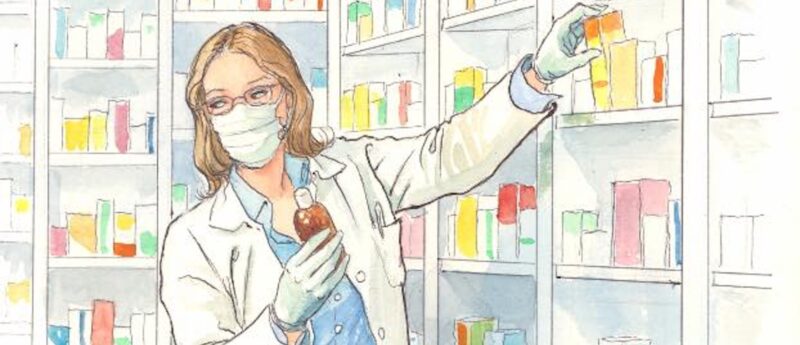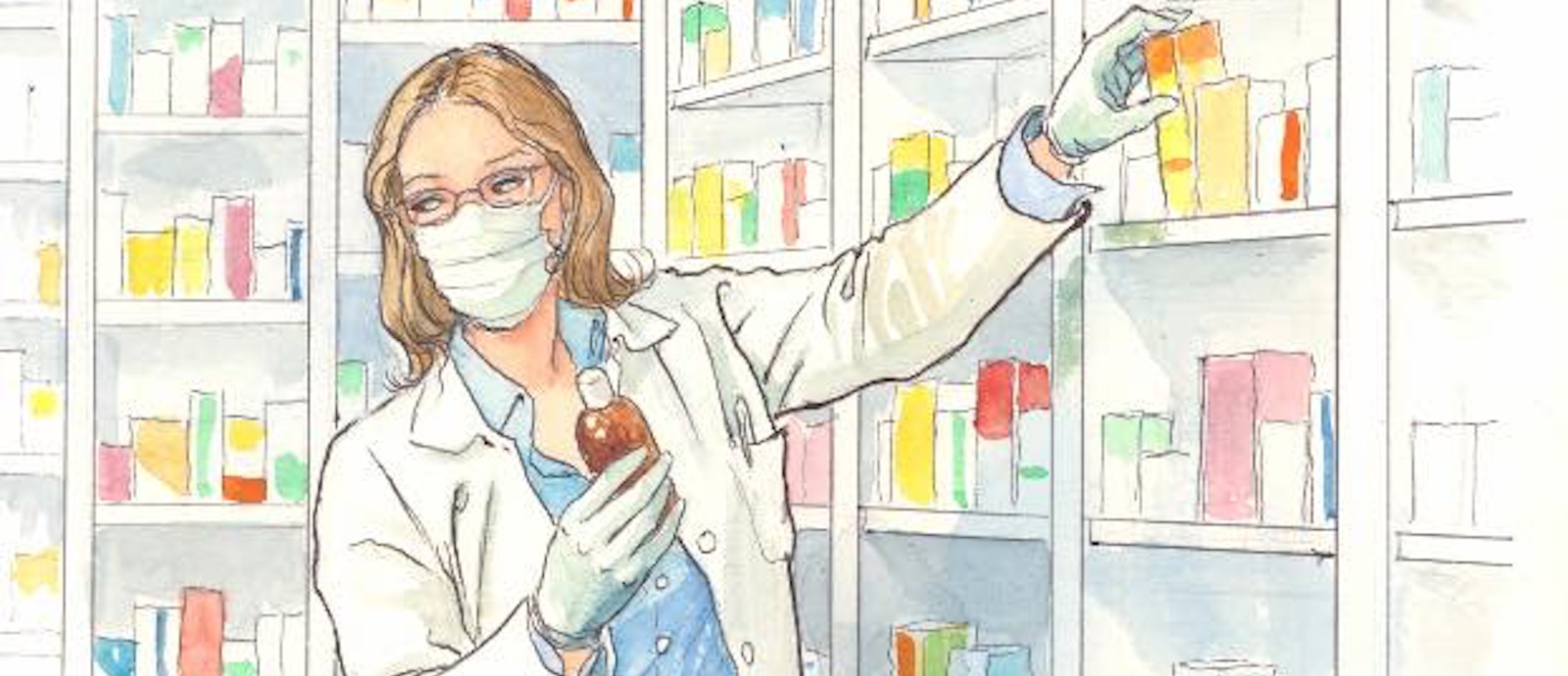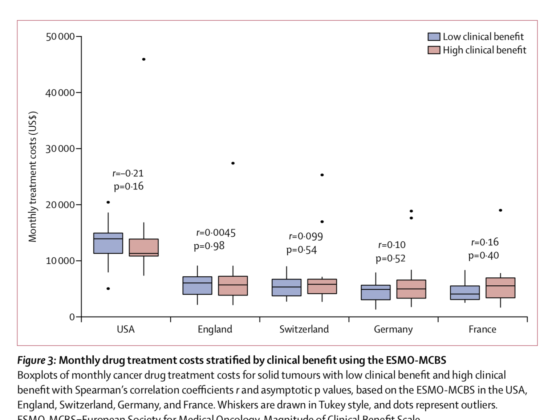The virtual scientific program of the 2020 American Society of Clinical Oncology (ASCO) Annual Meeting2020 hosted a special session on cancer and COVID-19 pandemic. Data from the Thoracic cancERs international coVid 19 cOLlaboraTion (TERAVOLT) registry and from the COVID-19 and Cancer Consortium registry (CCC-19) were presented: both studies were already discussed at the AACR virtual meeting, one month ago, but the outcomes are now more solid and consistent.
CCC-19, an American perspective
In patients with cancer and COVID-19, cancer that is progressing was independently associated with an increased risk of death, according to an analysis of 928 patients included in CCC-19.
The treatment with both hydroxychloroquine and azithromycin was also strongly associated with an increased risk of death. The registry contains data from patients who have tested positive for COVID-19 and around 40% of patients in the registry also have active cancer.
Lead author Jeremy L. Warner, Associate Professor of Medicine and Biomedical Informatics at Vanderbilt University Medical Center in Nashville said: “This is early and evolving data, and more time and analysis will be needed to confirm and expand on these findings. Right now, we’re working to get information about why some patients with cancer become infected and identify the factors that affect disease severity and death. We’re also interested in the effects of treatments that are being used to treat patients with cancer who have COVID-19.
Most of the patients were enrolled in the US and Canada but included also individuals in Argentina, Canada, the European Union, the United States, and the United Kingdom.
Breast cancer (21%) was the most common cancer, followed by prostate (16%), gastrointestinal (12%), lymphoma (11%), and thoracic (10%). In all, 43% of patients had active cancer, 39% were on cancer treatment, and 45% were in remission.
Negative effects from some COVID-19 treatments
In the CCC-19 study, 13% of the recruited patients died within 30 days of COVID-19 diagnosis. Patients with progressing cancer were found to be 5.2 times more likely to die within 30 days compared with patients in remission or with no evidence of disease.
The use of a combination of hydroxychloroquine and azithromycin was associated with a 2.89-fold greater risk of 30-day mortality than the use of neither drug. However, there was no significant increase in risk associated with the use of either drug alone.
Patients who received hydroxychloroquine and azithromycin and later died were more likely to have had slightly diminished daily physical function, received cancer therapy less than 2 weeks before COVID-19 diagnosis, have Rh-positive blood type, be of non-Hispanic ethnicity, and use statins at baseline.
“While these findings are provocative, we believe that there is significant confounding by indication and that carefully planned prospective studies are needed to truly demonstrate the risk or benefit of these drugs” Warner said.
Diminished ability to perform daily living activities – measured by an Eastern Cooperative Oncology Group (ECOG) Performance Status score of 2 or greater – was
associated with a 3.89 times greater risk of 30-day mortality compared with greater physical ability (ECOG score of 0/1).
Risk of death at 30 days increased nearly two-fold with each decade of life. In addition, stable, non-progressing cancer was associated with a 1.79 times greater risk of death than no evidence of disease. Men had a 1.63 times greater risk of 30-day mortality than women. Lastly, former smokers had a 1.6 times greater risk of mortality than non-smokers.
Half of patients included in this analysis (466) were hospitalized following onset of COVID-19. Overall, 14% of all patients were admitted to the intensive care unit. Mechanical ventilation was required for 12% of all patients, and additional oxygen was required by 44% of patients.
Researchers are planning to conduct further analyses on this dataset and longer follow-up as the registry continues to accrue patients.
Focus on lung cancer
The TERAVOLT study focused on thoracic malignancies, and recruited 400 patients – mostly from Europe and especially from Italy – since it was launched by Maria Chiara Garassino from the National Cancer Institute (INT) in Milan.
Patients with thoracic malignancies, which include lung cancer, mesothelioma, thymic neoplasms, and carcinoid tumors, are considered high risk given their older age, multiple comorbidities and pre-existing lung damage, among other factors. Of the 144 patients who died, 79.4% (112) died due to COVID-19 and 10.6% (15) due to cancer.
Lead author Leora Horn, Ingram Associate Professor of Cancer Research and the Director of the Thoracic Oncology Program at Vanderbilt University Medical Center said: “The data presented last month at AACR involving 200 patients were confirmed by this analysis on 400 patients. Only those treated with chemotherapy (alone or in combination with other therapies) within 3 months of COVID-19 diagnosis had a significantly increased risk (64%) of dying from the virus compared with patients not receiving chemotherapy”
Steroid and anticoagulation treatment as risk factors
Treatment with anticoagulants and corticosteroids prior to COVID-19 were also associated with an increased risk of death. Corticosteroids were associated with 1.5 times greater risk of death in patients with thoracic cancer, compared with patients not on corticosteroids.
Findings regarding prior anticoagulant treatment are of interest as well, given published reports of clotting in patients with COVID-19, which have prompted some physicians to recommend anticoagulation prophylaxis in all patients with this disease. However, there were too few patients for multivariate analysis. More data will be needed to understand how COVID-19 affects clotting in patients with thoracic cancer.
The type of treatment given specifically for COVID-19 did not appear to affect a patient’s risk of death. The proportions of patients receiving anticoagulants, antibiotics, antivirals, antifungals, corticosteroids, drugs targeting IL-6, and hydroxychloroquine were the same or similar for patients that recovered and that died.
Data collection is ongoing, and additional analyses are planned to examine patient and provider perceptions of the impact of COVID-19 on cancer care.
Many limits in both studies
Giuseppe Curigliano, Head of the Division of Early Drug Development at European Institute of Oncology, Italy, discussed both presentations.
“There is a huge difference in mortality rate between the two studies. While CCC-19 records a 13% mortality rate, TERAVOLT shows a 35.5% mortality rate. Even risk factors differ: a story of smoking and male sex increase mortality in CCC-19 but not in TERAVOLT, while steroid use and cancer stage are significant in both studies” Curigliano said.
“Differences can also depend from the general scenario: while CCC-19 recruited patients mostly in the US, when we already had some experience in treating COVID-19, TERAVOLT includes patients recruited during the Italian outbreak, the first and most intense outbreak outside of China. The level of preparedness and the availability of ICU beds are not comparable. US had 34.7 critical care beds per 100.000 inhabitants while Italy had only 12.5”
Nonetheless there are data from the New York City outbreak (published by Mehta and colleagues on May 2020), and collected when the outbreak overwhelmed the health care system, showing that mortality rate in cancer patients where significantly higher when compared with to all NYC COVID-19 cases (25 vs 14%). The study shows a 55% mortality rate among lung cancer patients, 38% among gastro-intestinal cancers patients and around 15% for other types of cancer (breast, genitourinary).
“We can assume that, even if in CCC-19 lung cancer patients have a mortality rate around 10%, this is only because the number of patients recruited is still too low” states Curigliano.
Both studies, according to the Italian expert, have limitations. In TERAVOLT, COVID-19 is often defined on clinical signs rather than on lab tests. In European centers the triage decisions where very challenging during the outbreak and probably led to a lower rate of access to ICU for lung cancer patients. TERAVOLT recruited mostly hospitalized patients, with a high proportion of stage IV NSLC, while CCC-19 had a higher proportion of patients in remission.
Both studies lack of clear data on deep vein thrombosis previous and current history and on pulmonary embolism and there is no clear definition for eligibility to ICU” remarks Curigliano. “Last but not least, these are cross-sectional studies. There is no real-time data capture, no auditing, no standardized definitions and there are limitations in terms of data collection. There are multiple biases, including selection bias, recall bias, confounding indications and changes in practices and disease evolution. There is no propensity for score adjustment, no control with non-cancer patients, no stratification for stage and lines of previous therapies and other covariate adjustment. Serious confounding remains due to the impact of unmeasured risks on treatment decisions”.
There is also a lesson to be learnt from these studies, concluded Curigliano: CCC-19 and TERAVOLT are the largest real world dataset investigating risk of hospitalization and death in cancer patients and they reflect un unprecedented global effort to collect data of patients with cancer affected by COVID-19. In both studies, independent factors associated with increased mortality after adjustment were older age, number of comorbidities, ECOG performance score of 2 or more, active cancer and chemotherapy alone or in combination.
There are still open questions like cancer care prioritization and care intensity optimization in relation with the level of R0, from an almost normal situation to the most severe pandemic peak. We don’t know if cancer patients should be prioritized for ICU triage or admitted on the basis of the disease stage and general evaluation.
“How would we ensure that all patients with cancer get triaged fairly?” said Curigliano.” And Is immunotherapy protective on infection and COVID-19 outcome?”. He also suggested some research priorities. “We should understand the utility of PCR testing. Longitudinal serological studies are urgently needed to determine the extent and duration of immunity. We should develop an epidemiological model to estimate the cumulative incidence of COVID-19 within specific timeframe and pandemic scenario and identify viral, environmental and immunologic factors that, in combination, will determine the dynamics of SARS-CoV-2. And, finally, we clearly need to determine COVID-19 morbidity and mortality according to cancer treatment, from chemotherapy to targeted therapies and immune-checkpoint blockade”.
What lesson can we use to move forward?
“We learnt that transparency is the best policy: we need data, fast and reliable. We learnt that we can develop a strong collaboration among clinicians and scientist in a very short time. And we realized that XXI century science played a relatively small role in controlling the pandemic; XIX century methodology continued to prove its value through social distancing and hygienic measures”.
About the cartoon that illustrates this article: In recent weeks, Milo Manara, one of the most renowned Italian cartoonist, has paid homage to people who are continuing to work and offer vital services despite the health emergency linked to Coronavirus, with a series of drawings published on its social networks.
Milo Manara’s designs are dedicated to healthcare personnel, riders, couriers, law enforcement and supermarket clerks. In addition, the designer has made a short animated video dedicated to hospital staff, at the forefront of the pandemic.












